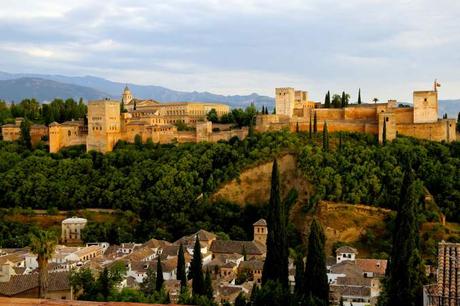We have wanted to visit Granada for a very long time and last week, finally flew out from London City Airport for a short break. Taking a bus from the airport and then a second short mini bus ride which dropped us at our hotel in the Albaycin area all made for an easy journey. We dumped our bags and wandered up to the square to catch our first view before the day’s forecast rain.

Alhambra viewed from Mirador St. Nicholas in the Albaycin area
The literal translation of Alhambra is “the red one”, constructed from clay, the buildings glow in the sunset, even on a cloudy evening. Only the Generalife, the Sultans summer palace, a short walk from the Nasrid Palaces is white. Behind, the Sierra Nevada mountains were still partly snow capped – the melt provides Granada’s water.

The Generalife – Sultans Summer palace -white building on left – a short walk from the Nasrid Palaces on right – view from Sacromonte
There are records showing occupied buildings in the Alhambra area from 880, although it was not until the 12th and 13th centuries that gardens were built there for the Nasrid rulers, an Arab dynasty. In 1492 Granada fell to Ferdinand and Isabella and the last Muslim territory in Spain was surrendered to the Christians. In 1526 Charles V of Spain occupied the area and built his palace. A period of neglect followed and it was not until the 19th century when Washington Irvin, the American novelist and other romantic travellers rediscovered the Alhambra that the restoration began.

The Court of the Myrtles
The temperatures were soaring into the mid 30s as we queued for the first of our two visits to Nasrid Palaces, which include The Court of the Myrtles and The Court of the Lions. 300 people are allowed to visit per hour but with patience, there are brief moments of almost no-one there. The central pool is 34 metres long and 7. 10 meters wide. The pond divides the patio and receives its water from two fountains (one at each end of the pond).
The Nasrid Palaces comprise of three independent areas – the Mexuar, which corresponds to the semipublic part of the palace for justice administration and State affairs; the Comares Palace which was the official residence of the king; and the Palace of the Lions which was the private area of the palace. The Comares Palace surrounds The Court of the Myrtles which was built for Yusuf I (1333-54) and the Palace of the Lions surrounds the Court of the Lions built for his son Muhammad V. Most of what is seen today has been reconstructed.

Beautifully clipped Myrtle Hedges
The Myrtle Hedges are beautifully clipped, the only signs ask visitors not to touch plants! But it was virtually irresistible to press a myrtle leaf between my fingers to release the fragrance. Our second visit at nighttime, the following evening shows the Stucco arches reflected in the water and the fountains at either end of the pool.

Court of Myrtles at Night time
The Myrtles were planted in the 19th century and were not included as a hedge in the original garden design. Throughout time there have been other names for this court, its current name is due to the Myrtles. It was also called the Patio of the Pond or the Reservoir because of its central pond. Leading from the Court of the Mrytles we walked through the Comares or throne room to the Court of the Lions.

Arch detail in the Comares or Throne room
Surrounding the Court is the Palace of the Lions and is probably the most famous part of the Alhambra. This patio was built for Mohammed V. The style is of a Christian cloister rather than the typical Muslim Andalusian style of the Court of the Myrtles.

Palace of the Lions
It is so called because of the twelve lions that throw jets of water and which are part of the fountain in the middle of the patio.

12 Lions
Our visit during the day time was busy but the following evening we managed by chance to be first in the queue and for a exhilarating brief minute or so we were alone in the Court of Lions.

The Court of the Lions at night time
The gallery is supported by 124 white marble columns with fine shafts, which are intricately decorated.

One of two Pavillions – Palace of the Lions, simply planted with four Orange trees
The evening visit to the Nasrid Palaces includes only these two gardens but during the day the route leads on though the Court of Lindaraja and finally into the Palace of the Partal and the restored Partal gardens.

Balcony overlooking the Court of Lindaraja
I have so much to share with you, I thought its best to divide this trip up into 2 posts and later will post one on the Partal Gardens and the Generalife, although the places open for public visiting are divided into four areas. Alcazaba, seen on the far right in the first photo, essentially a fortress. The Nasrid Palaces on the left in my first photo. (The later added Charles 5th Palace can be seen sitting behind the Nasrid Palaces). The Partal gardens, essentially the area linking everything up and Generalife.

One of two Pavillions – Court of the Lions
Booking tickets to visit is a complicated business. Our hotel gave us the heads up that tickets are released 6 weeks in advance and sell out very quickly, so for a June 1st visit they were released on April 20th. There are lots of options including guided tours on the Alhambra official website and bookings were through ticketmaster.
